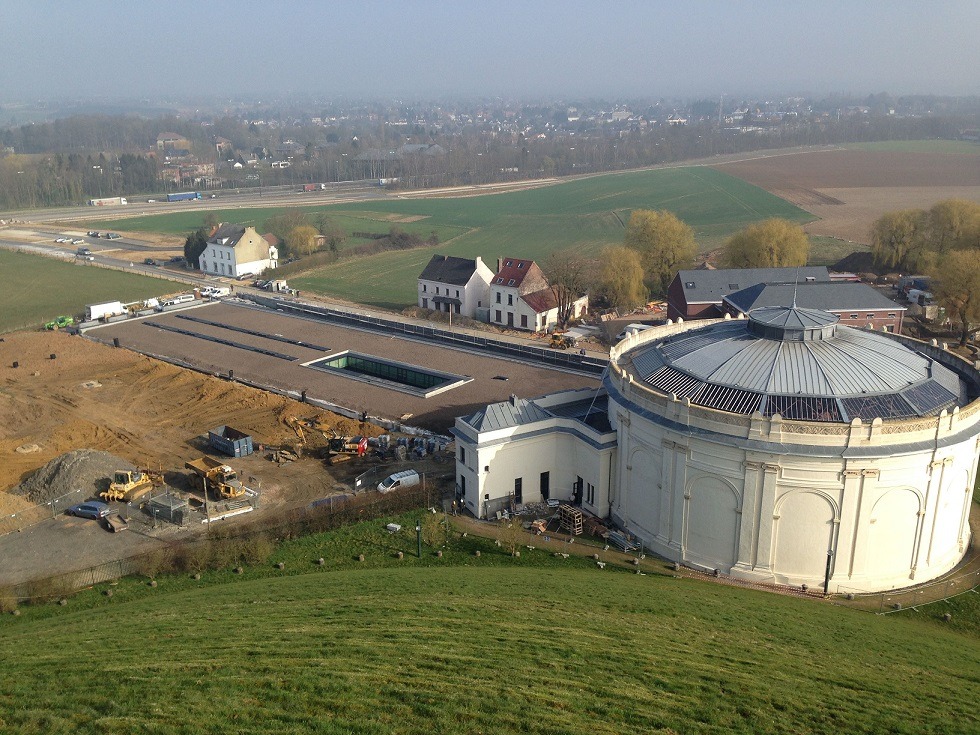Wallonia's tourism minister Rene Collin says a new Battle of Waterloo memorial will double the number of visitors to the site and help boost tourism for the whole region. Speaking at a news conference to promote the new 1815 Memorial, the minister admitted it had been a "real challenge" trying to meet the completion date.
But he pledged that the underground museum will open to the public as planned on 22 May.
He told journalists,"It has been a real challenge in terms of timing and administrative procedures but this has been taken on board. We will be ready."
The new memorial, 10 metres below ground surface, replaces the old, outdated museum and panorama on the site of the famous battle which marks its 200th anniversary in June. The reception hall is located 5m lower.
Earlier this week, the international and Belgian press were given a sneak preview of the contents and the ongoing works.
The memorial contains dozens of uniforms and collectables, numerous precious collections and guests can learn about the tactics employed by the Duke of Wellington and Napoleon as they converged on Mont Saint Jean.
There is also a 3D, 25m panoramic screen displaying key moments from the battle in a 15-minute film filled with special effects.
The memorial's roof is covered in grass as it would have been back in 1815. This is also to help preserve the battlefield which currently attracts up to 300,000 visitors a year.
The works , which have cost an estimated 9 million euros, has seen the number of visitors fall in the past year but, even so, some 150,000 people still visited the site in 2014.
Construction, including the use of locally sourced building products, started in May 2012 and was due to be completed this month.
Back in 1997 the site was full of bars, stalls, chip shops and restaurants in need of major refurbishment.
Several buildings had to be demolished for the redevelopment, and car parks, now holding up to 350 vehicles, have been adapted to accommodate an increased number of visitors. One aim was to cut down high levels of traffic (more than 10,000 vehicles per day) and the area is now largely pedestrian-only.
About 300,000 people visit the site each year but the various organisations behind the ambitious project hope the memorial, along with other developments on the site such as a restoration of the nearby Hougoumont Farm, will see this at least doubled.
Collin said, "These major works are not just for the bicentenary but intended to be a sustainable development for years to come. I am confident it will provide a major spur for tourism in the whole of Wallonia."
His comments were echoed by Claude Goelhen, from the Bureau d'Engineering et d'Architecture Industrielle, who also said the building incorporates several "envoironment friendly" components.
“The site is promoting a brand of tourism that respects both the historical and natural heritage of the battlefield,” he said.
The memorial, which measures some 5,700 square metres and is made from reinforced steel and concrete, is well insulated and cooled by geothermic technology.
The access ramp to the entrance is lined by the "Mur de la Memoire" remembrance wall on which are written the names of every regiment that took part in the battle on 18 June 1815.
The memorial is the centrepiece of a whole site that has been subject to major improvement ahead of the much-awaited bicentenary commemorations.
To commemorate the 200th anniversary, Nathalie du Parc Locmaria, of the ASBL ‘Bataille de Waterloo 1815’ said, "We have planned the most impressive reconstructions ever seen in Europe,including 5,000 re-enactors, 300 horses and 100 canons."
Further comment came from Philippe Chiwy, from the La Belle Alliance association, a group of seven different companies, who said the aim of the memorial was to help relive the experience for visitors.
One objective is to underpin its status as a major destination for remembrance tourism.
Chiwy said, "The aim is not to take sides or say one general was better than the other. Rather, we want to make visitors understand why the battle took place and why the name Waterloo has gained such mythical status all over the world."
By Martin Banks

